Name Cap Trafalgar In service 1 April 1914 Launched 31 July 1913 Weight 24,020 tons Beam 22 m | Yard number 334 Length 187 m Displacement 21.45 million kg | |
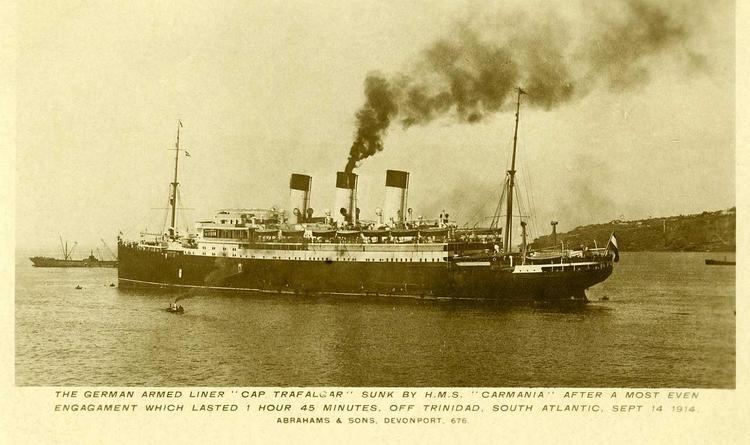 | ||
Owner Hamburg Südamerikanische Dampfschifffahrts-Gesellschaft Fate Sunk in combat, 14 September 1914 Builders AG Vulcan Stettin, Hamburg | ||
SMS Cap Trafalgar (also called Cape Trafalgar) was a German passenger liner converted to an auxiliary cruiser during World War I. The ship holds the distinction of being the first armed merchant cruiser to have been sunk by a ship of the same class; she was destroyed in a furious action in the South Atlantic in September 1914 soon after the start of the war.
Contents
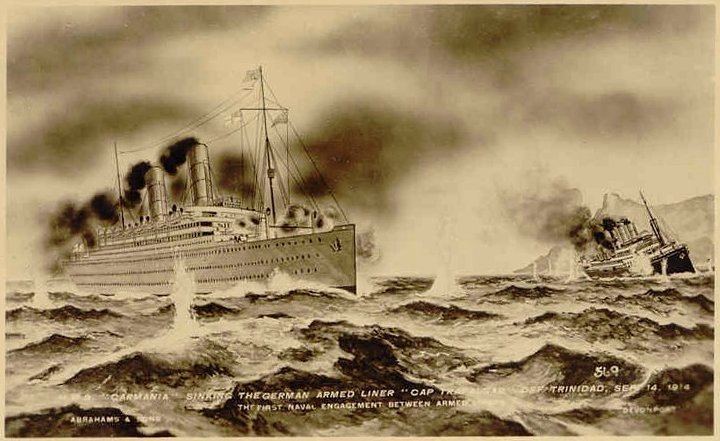
Early career

The passenger liner SS Cap Trafalgar was built at the AG Vulcan Shipyard on the Elbe River in Hamburg, Germany for the Hamburg-South America Line for their service between Germany and the River Plate (Río de la Plata). She was named after the Spanish Cape Trafalgar, scene of the famous Battle of Trafalgar in 1805. A three-funneled vessel of 613 ft (187 m) length and 72 ft (22 m) beam, she measured 18,710 GRT and could carry nearly 1,600 passengers (400 1st class, 276 2nd class, 913 3rd or steerage class. A triple-screw vessel, her outer propellers were powered by two triple-expansion steam engines, and the centre screw by an exhaust turbine, an arrangement similar to that of the RMS Titanic.

When Cap Trafalgar began her maiden voyage on 10 April 1914 from Hamburg for South American ports in Brazil, Argentina and Uruguay, she was the largest vessel hitherto on the South American service and among the most luxurious.
World War I battle with Carmania
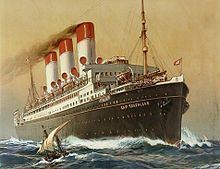
When war was declared in Europe in August 1914, Cap Trafalgar was in Buenos Aires and was laid up pending orders. As already planned, the German Imperial Navy requisitioned her as an auxiliary cruiser. On 18 August she arrived in Montevideo for coal and then sailed to rendezvous at the remote Brazilian island of Trindade, 500 miles east of the Brazilian mainland, with the gunboat SMS Eber, which transferred naval officers, ammunition and armaments to the liner. At the same time, her third funnel (a dummy) was removed.
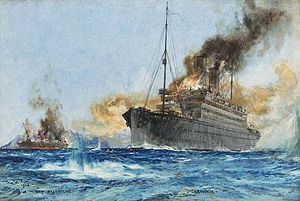
She was armed with two 4.1 inch guns and six one-pounder pom-poms, all manned by experienced naval personnel, and given the mission to sink British merchant shipping. She was given the codename Hilfskreuzer B (Auxiliary Cruiser B) and was commanded by Korvettenkapitän (Lieutenant Commander) Wirth. After an initial fruitless cruise, Cap Trafalgar returned on 13 September to the secret supply base at Trindade Island to take on fuel from German colliers.
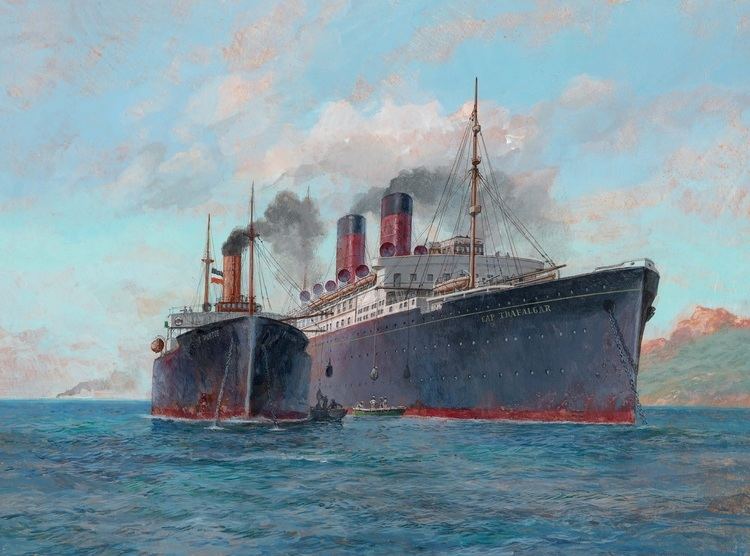
It was at this base on 14 September that Cap Trafalgar was discovered by the British armed merchant cruiser HMS Carmania, a liner belonging to the Cunard Line which had been converted to a convoy escort and raider designed to flush out German colliers and small warships that might be using the inhospitable island as a base against British merchant shipping. Carmania spotted Cap Trafalgar's smoke early in the morning and some hours later was able to surprise the German ship with two colliers in the island's only harbour. By coincidence, the Cap Trafalgar was disguised as the Carmania. (Some accounts amusingly, but incorrectly, allege that the Carmania was itself disguised as the Cap Trafalgar.)
Both the captains of the Cap Trafalgar and the Carmania had realized that to fight a successful action, their respective vessels required plenty of room; so, the captains had separately steamed several miles from the outcrop of the Island of Trindade in order to gain the space required. The Cap Trafalgar also sent out encoded German messages, announcing the engagement with the Carmania, and the position as 35 degrees west, 26 degrees south, with a NNW heading. Then the two ships turned towards each other and began to fight, the Carmania firing too early and thus allowing the Cap Trafalgar the first blow. Carmania suffered much the worse of the engagement in the ensuing two hours, being hit 79 times, was holed below the waterline, and had her bridge totally destroyed by shellfire. However, as the range closed her own guns began to tell, and fires broke out on both ships, sailors lining the rails and firing machine guns at their opposite numbers as the ships came within a few hundred yards of each other, in a style of fighting more akin with the Napoleonic Wars than the First World War.
Just as it seemed that the fires on Carmania would burn out of control, Cap Trafalgar veered away, lowering lifeboats as she heeled over to port. A shell below the waterline had ruptured several compartments, and the ship was rapidly sinking, although the colliers were able to pull 279 sailors from the wreck before she sank. Fifty-one were killed in the fighting or the sinking (other reports say sixteen or seventeen lives were lost), including Captain Wirth. Carmania was equally shattered, listing severely, heavily flooded and burning, with nine men dead and many more wounded. It was at this point that Cap Trafalgar's contemporary, the armed merchant cruiser SMS Kronprinz Wilhelm arrived, seemingly to provide the coup de grace for the shattered ship. However, the Kronprinz Wilhelm's captain feared a trap, since many ships both German and Allied in the area had doubtless been listening to the SOS calls of the Cap Trafalgar, which, though in German code, had been supplemented by messages from the Carmania with the British code. Since multiple warships were on their way to the location, and the Cap Trafalgar had presumably already sunk, the captain of the Kronprinz Wilhelm turned his ship about and sailed away without firing a shot. (Von Niezychowski, 1928)
The following day the Carmania was rescued and brought into Pernambuco by other units of the Royal Navy, whilst the survivors of the Cap Trafalgar were rescued by the collier Eleonore Woermann and taken to Buenos Aires. Most were interned for the duration of the war on the Argentine-controlled Martín García Island.
